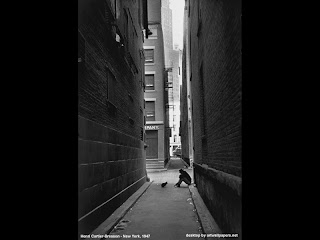Cartier-Bresson trained as an artist before starting a career as a photographer in the 1930's. With Robert Capa, David Seymour and others he founded Magnum, a photographic agency and has worked and exhibited all over the world.
"For me photography is to place head heart and eye along the same line of sight. It is a way of life" Henri CB
Many of his photographs are iconic and are well known outside the photographic community.
Cartier Bresson took up photography when the so called 'snapshot' photo was invented, with pictures no longer posed or set up, but capturing an isolated moment, it was new in its time since highly posed and polished images were the norm, along with avant-garde artistic images, as in the experimental work of Man Ray and the surrealists.
Glass tears - Man Ray
"So what is a snapshot? The intensification of a fracture between two classes of image: those that are man-made, like painting and drawing, and those created machanically by imprinting light on sensitive film. Images in the first category are unique works. The rest, because they are capable of being reproduced, are judged not by their uniqueness but by the unique moment they record..... Cartier-Bresson waits in ambush for the right time to occur. Siezing that moment is a matter of instinct". Jean-Noel Jeanneney, President of the Bibliotheque nationale de France.
In this image a girl leaning on a pillar in the bottom right, is echoed by a shadow at the top of the stairwell adding an element of human interest to an otherwise static scene. Here dark and light make up most of the picture with the shadow of the pillar and girl pointing directly up the stairs, which also narrow as they rise adding perspective and a feeling of depth.
This is another image with bright light illuminating alleyways between buildings, the zig zag of light leads you directly into the picture, with a figure caught resting against a wall in the shade.
Another small figure with towering buildings, the focal point is placed slightly off centre in the bottom two thirds, with all the light pointing directly to it.
This image by Edward Swindon seems to be directly influenced by Cartier-Bresson's earlier work, although he has pared this series of pictures down, to show only a small strip of light illuminating the figure, with the dark area taking up most of the image area, this concentrates your gaze directly to the focal point, and the story of the figure forming a miniscule part in a much larger whole, as bees in a hive or worker ants.
Bright strips of light point directly between buildings guiding the eye into the picture, forming leading lines, with figures caught standing in the shade adding a focal point and animating the scene.
In my final images I would like to emulate the work of Cartier-Bresson and more modern photographers such as Edward Swinden.
Sources - 'Henri Cartier-Bresson the man, the image, & the world' a retrospective by Foundation Henri Cartier Bresson. (book)










No comments:
Post a Comment